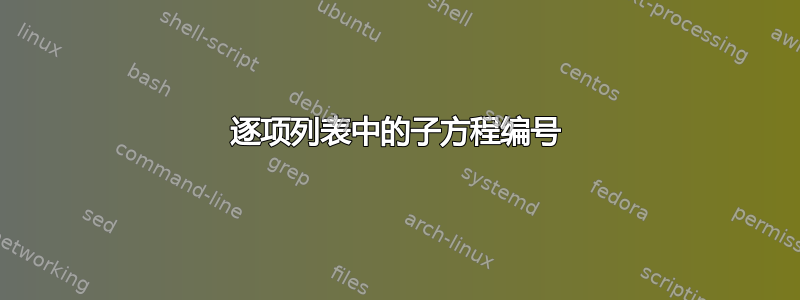
这是我为一组等效定义生成的半正定性。
\documentclass[10pt]{article}
% for fancy math
\usepackage{amsmath}
% rank operator
\DeclareMathOperator*{\rank}{rank}
% Matrix transpose
\newcommand{\trans}[1]{\ensuremath{{#1}^\top}}
% for extra space at the end of abbreviation
\usepackage{xspace}
% positive semi-definite
\newcommand{\psd}{\textsc{psd}\xspace}
% boldface uppercase letters for matrices
\newcommand{\Abf}{\ensuremath{\mathbf A}}
\newcommand{\Bbf}{\ensuremath{\mathbf B}}
% boldface lowercase letters for vectors
\newcommand{\xbf}{\ensuremath{\mathbf x}}
% for math blackboard font
\usepackage{amssymb}
% set of real numbers
\newcommand{\Rbb}{\ensuremath{\mathbb R}}
\usepackage{palatino}
\usepackage[sc]{mathpazo}
\begin{document}
\noindent
For any real symmetric matrcies $\Abf$ such that $\rank(\Abf_{n\times n})=r$,
the following statements are equivalent
and any one of them can serve as the definition of
\emph{positive semi-definite} (\psd) matrices.
\begin{itemize}
\item $\trans\xbf \Abf\xbf \geq 0$ for any non-zero vector
$\xbf\in\Rbb^{n\times 1}$.
\hfill\refstepcounter{equation}\textup{(\theequation)}%
\item All the $n$ eigenvalues of $\Abf$ are non-negative.
\hfill\refstepcounter{equation}\textup{(\theequation)}%
\item $\Abf=\trans\Bbf \Bbf$ for some $\Bbf$ with $\rank(\Bbf)=r$.
\hfill\refstepcounter{equation}\textup{(\theequation)}%
\end{itemize}
\end{document}

由于这些定义都是等价的,我想将它们编号为 (1a)、(1b) 和 (1c),而不是 (1)、(2)、(3)。我不确定是否可以使用subequations环境,因为我想将三个不同的定义保留为逐项列表中的文本。
有什么建议么?
答案1
只需添加:
\begin{subequations}
...
\end{subequations}
在您的周围itemize环境中。
答案2
这是这种布局的另一种视图,可避免手动插入方程编号:

\documentclass[10pt]{article}
% for fancy math
\usepackage{amsmath}
% rank operator
\DeclareMathOperator*{\rank}{rank}
% Matrix transpose
\newcommand{\trans}[1]{\ensuremath{{#1}^\top}}
% for extra space at the end of abbreviation
\usepackage{xspace}
% positive semi-definite
\newcommand{\psd}{\textsc{psd}\xspace}
% boldface uppercase letters for matrices
\newcommand{\Abf}{\ensuremath{\mathbf A}}
\newcommand{\Bbf}{\ensuremath{\mathbf B}}
% boldface lowercase letters for vectors
\newcommand{\xbf}{\ensuremath{\mathbf x}}
% for math blackboard font
\usepackage{amssymb}
% set of real numbers
\newcommand{\Rbb}{\ensuremath{\mathbb R}}
\usepackage{palatino}
\usepackage[sc]{mathpazo}
\newcommand{\mathitem}{\hspace*{1.2em}&\bullet\hspace*{\labelsep}}
\begin{document}
\noindent
For any real symmetric matrcies $\Abf$ such that $\rank(\Abf_{n\times n})=r$,
the following statements are equivalent
and any one of them can serve as the definition of
\emph{positive semi-definite} (\psd) matrices.
\begin{itemize}
\item $\trans\xbf \Abf\xbf \geq 0$ for any non-zero vector
$\xbf\in\Rbb^{n\times 1}$.
\hfill\refstepcounter{equation}\textup{(\theequation)}%
\item All the $n$ eigenvalues of $\Abf$ are non-negative.
\hfill\refstepcounter{equation}\textup{(\theequation)}%
\item $\Abf=\trans\Bbf \Bbf$ for some $\Bbf$ with $\rank(\Bbf)=r$.
\hfill\refstepcounter{equation}\textup{(\theequation)}%
\end{itemize}
\noindent
For any real symmetric matrcies $\Abf$ such that $\rank(\Abf_{n\times n})=r$,
the following statements are equivalent
and any one of them can serve as the definition of
\emph{positive semi-definite} (\psd) matrices.
\begin{subequations}
\makeatletter\@fleqntrue\makeatother
\begin{align}
\mathitem \text{$\trans\xbf \Abf\xbf \geq 0$ for any non-zero vector
$\xbf\in\Rbb^{n\times 1}$.} \\
\mathitem \text{All the $n$ eigenvalues of $\Abf$ are non-negative.} \\
\mathitem \text{$\Abf=\trans\Bbf \Bbf$ for some $\Bbf$ with $\rank(\Bbf)=r$.}
\end{align}
\end{subequations}
\end{document}
align这个想法是在环境中设置一个常规subequations,暂时将其刷新到左边距(通过激活\@fleqntrue)。如果您想要增加元素之间的间隙(因为它们在 下稍微紧密一些align),请\\[<len>]在指定 的位置使用<len>。
答案3
为什么不直接列出清单呢:
\begin{itemize}
\item $\trans\xbf \Abf\xbf \geq 0$ for any non-zero vector
$\xbf\in\Rbb^{n\times 1}$.
\hfill\refstepcounter{equation}\textup{(\theequation a)}%
\item All the $n$ eigenvalues of $\Abf$ are non-negative.
\hfill\refstepcounter{equation}\textup{(\theequation b)}%
\item $\Abf=\trans\Bbf \Bbf$ for some $\Bbf$ with $\rank(\Bbf)=r$.
\hfill\refstepcounter{equation}\textup{(\theequation c)}%
\end{itemize}


